
Waking up in Paris on any morning is wonderful. Actually, at my age, just waking up is wonderful and a reason for celebration. But what I want to say is that anyone from anyplace who doesn’t love waking up in Paris, no matter how many times he has been there, doesn’t deserve the pleasure and should go somewhere else immediately. Anything I say here about Paris will undoubtedly be a cliche. Any picture of Paris that I include here you will have seen already on a hundred postcards. It doesn’t matter. That is the magic of the place.
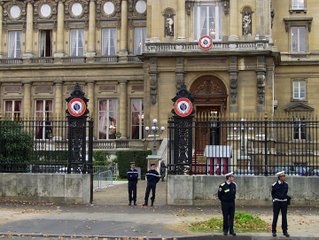 The ubiquitous Gendarme is standing more than patrolling, but who can blame anyone in Paris for seeming transfixed and dazzled. Ambulances and police escorts with the distinctive honking sirens dash through crowded streets. An elegantly coifed lady wearing her autumn fur looks away pretending not to notice what her dauchund is doing on the sidewalk. On the bank of the Seine in front of the Assemblee Nationale perch a few tents that are homes for the enterprising homeless of the city or perhaps a night’s lodging for an American youngster who prefers to keep the fifteen dollars it would take get a room in a hostel and use it instead for quite good, cheap French wine, which he can buy without being carded. The only people who aren’t hurrying are the ones walking dogs.
The ubiquitous Gendarme is standing more than patrolling, but who can blame anyone in Paris for seeming transfixed and dazzled. Ambulances and police escorts with the distinctive honking sirens dash through crowded streets. An elegantly coifed lady wearing her autumn fur looks away pretending not to notice what her dauchund is doing on the sidewalk. On the bank of the Seine in front of the Assemblee Nationale perch a few tents that are homes for the enterprising homeless of the city or perhaps a night’s lodging for an American youngster who prefers to keep the fifteen dollars it would take get a room in a hostel and use it instead for quite good, cheap French wine, which he can buy without being carded. The only people who aren’t hurrying are the ones walking dogs. 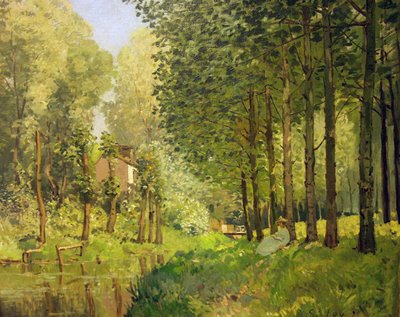 On this short visit Margaret and I focused our attention on the Musee d’Orsy across the river from the better known Louvre. The collection of French Impressionist art in the gallery that was once a railway station includes important works by Gauguin, Manet, Maillol, Monet, Pissarro, Picasso, Renoir, Rodin, Seurat and many other artists.
On this short visit Margaret and I focused our attention on the Musee d’Orsy across the river from the better known Louvre. The collection of French Impressionist art in the gallery that was once a railway station includes important works by Gauguin, Manet, Maillol, Monet, Pissarro, Picasso, Renoir, Rodin, Seurat and many other artists.  Le Ropos Bord du Ruisseau Lisieve Bos by Sisley is one of my favorites. It has everything in it that I like to include in a photograph. Gerome’s Executant les Gladieteurs stands with several Rodin sculptures in the great chamber where trains once roared into and out of the center of Paris.
Le Ropos Bord du Ruisseau Lisieve Bos by Sisley is one of my favorites. It has everything in it that I like to include in a photograph. Gerome’s Executant les Gladieteurs stands with several Rodin sculptures in the great chamber where trains once roared into and out of the center of Paris.After the Musee d”Orsay we walked on along the river to the Ile de la Cite and Cathedral Notre Dame, then on through the Place de Concorde, onto the Champs Elysees in time to walk around the Arc de Triumph just before sunset. We walked back to the river again and got to The Trocadero just after the sun went down. Our hotel was a ten-minute walk from the Eiffel Tower.
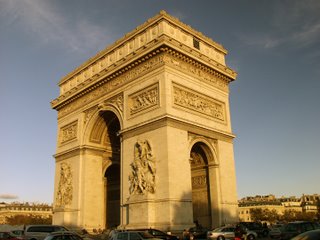
Prima Vista
Who doesn’t long to be the kind of musician who can read a score for the first time and play it as if it’s been practiced many times. This wasn’t my first time in Paris or Venice, but I like to think I can go into a city or any place that is new to me and move around comfortably the way a gifted musician moves through an unfamiliar piece of music.
 Since the days when English and American people of means finished their education with a Grand Tour of Europe, Venice has been a tourist destination. Now it doesn’t take a family fortune to afford the trip. and hoards of young people from all over the world, bent under their backpacks and studying their travel books, cluster and gossip where English students newly graduated from Cambridge and Oxford once stood.
Since the days when English and American people of means finished their education with a Grand Tour of Europe, Venice has been a tourist destination. Now it doesn’t take a family fortune to afford the trip. and hoards of young people from all over the world, bent under their backpacks and studying their travel books, cluster and gossip where English students newly graduated from Cambridge and Oxford once stood.
St. Mark’s, a Roman Catholic church in Catholic Italy, but in its design it is kin more to churches in Eastern and Russian Orthodox churches.
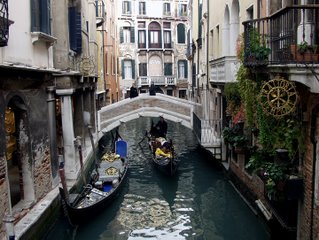
You may go in autumn or winter hoping for fewer people in the narrow streets; but, like the pigeons, the people are always there. The crowds are less hurried, less frenetic, less confused.
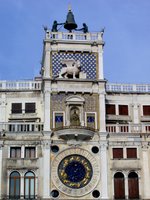 The pigeons are not relaxed, however. Anybody who stands still for a minute gets a pigeon on his head. An arm held out is an invitation for a pigeon to perch. A couple of small restaurant orchestras take turns playing for their customers and the general public. The famous old clock signals the passing of each hour. In spite of the inevitable, unthinkable consequences of global warming, Venice, like Paris, seems eternal.
The pigeons are not relaxed, however. Anybody who stands still for a minute gets a pigeon on his head. An arm held out is an invitation for a pigeon to perch. A couple of small restaurant orchestras take turns playing for their customers and the general public. The famous old clock signals the passing of each hour. In spite of the inevitable, unthinkable consequences of global warming, Venice, like Paris, seems eternal. DUBROVNIK, CROATIA
 Mediterranean people are long-suffering but optimistic. Only fifteen years ago little Croatia was attacked by neighbors Serbia and Montenegro, and the Medieval city of Dubrovnik was badly damaged. Dozens of bombs were lobbed over the old city walls destroying or damaging many homes and leaving a row of craters in the old main street. The city has recovered. The republic is working to become a member of the European Union within the next decade.
Mediterranean people are long-suffering but optimistic. Only fifteen years ago little Croatia was attacked by neighbors Serbia and Montenegro, and the Medieval city of Dubrovnik was badly damaged. Dozens of bombs were lobbed over the old city walls destroying or damaging many homes and leaving a row of craters in the old main street. The city has recovered. The republic is working to become a member of the European Union within the next decade.
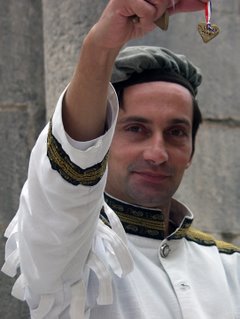 The old Pile Gate on the side of Dubrovnik away from the port survived the shelling with only a few pock marks. Souvenir sellers seem not to remember the bad times.
The old Pile Gate on the side of Dubrovnik away from the port survived the shelling with only a few pock marks. Souvenir sellers seem not to remember the bad times.
No comments:
Post a Comment